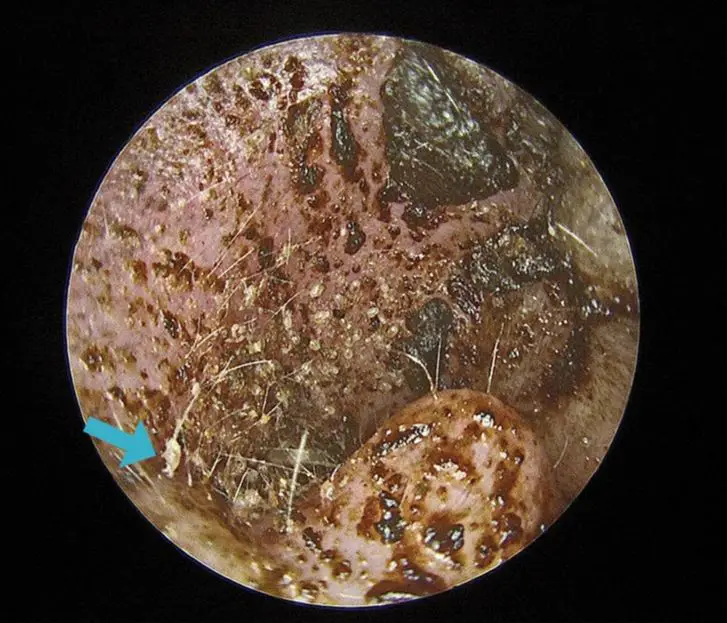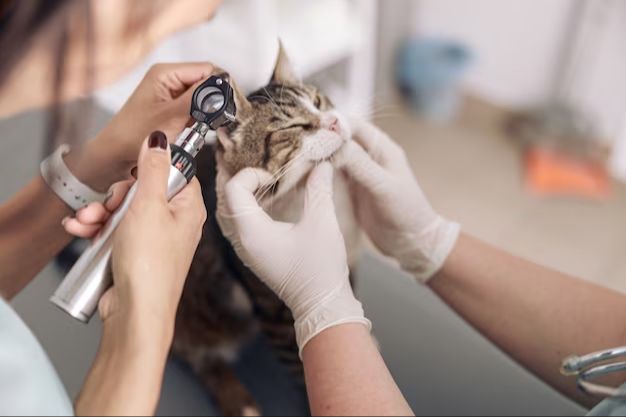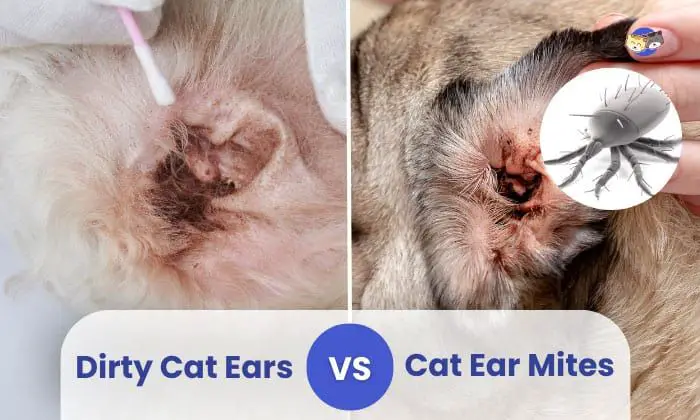What Are Cat Ear Mites?
Cat ear mites, scientifically known as Otodectes cynotis, are microscopic parasites that live on the skin of a cat’s ear canal. The mites feed on earwax and oils in the ears. The mites transfer between cats through direct contact. Mother mites will lay eggs in the ear canal, taking about 3 weeks for them to incubate and hatch into nymphs. The nymph mites mature into adults in about 3 weeks. Ear mites are highly contagious between cats and can spread rapidly (source).

A cat with an ear mite infestation will often shake its head and scratch at its ears excessively. The irritation leads to inflammation, which can be identified by a dark discharge resembling coffee grounds. The inflammation can cause ear hematomas in severe cases. The mites may spread from the ears to the skin around the neck and head. The constant itching and scratching is extremely uncomfortable for the cat (source).
Can Cat Ear Mites Transfer to Humans?
While rare, it is possible for cat ear mites (Otodectes cynotis) to transfer to humans in some cases. Ear mites are highly contagious among cats and canine species, but generally do not find the human ear canal a viable environment. However, direct transmission from an infected cat to a human can occur in certain circumstances.
According to the Centers for Disease Control and Prevention, ear mites are species-specific and prefer to live on animals. They usually cannot complete their life cycle on humans. However, human infestation is possible through direct contact with an infected animal (1).
For ear mites to be transmitted from a cat to a human, the mites would need direct access to the human ear canal. This could potentially happen if an infected cat sleeps next to its owner’s head at night. The mites may crawl from the cat’s ear into the human ear if given the opportunity.
While rare, some cases of human ear mite infestation have been documented in the literature. A 1987 case report described a 9-year-old girl who was successfully treated for ear mites after close exposure to an infected kitten (2). Overall, transmission seems to require prolonged, direct contact with an infested cat.
With prompt treatment of the infected cat, the risk of human transmission can be greatly reduced. Keeping cats indoors and away from strays can also lower the chances of infestation. Still, human cases are very rare even with exposed cats in the home.
(1) https://www.cdc.gov/parasites/scabies/health_professionals/a-z.html#e
(2) https://www.ncbi.nlm.nih.gov/pubmed/3624483
What Are the Symptoms in Humans?
Ear mites rarely transfer from cats to humans, but if an infection does occur, the most common symptoms include:

- Itching inside the ear canal
- Inflammation and redness
- Excess earwax production
- Feeling of fullness in the ear
- Black debris resembling coffee grounds in the ear canal
Cat ear mites mainly affect the ear canal and external ear. The mites burrow into the skin causing irritation, inflammation, and buildup of earwax. In some cases, the ear canal can become partially or fully blocked by debris. Secondary infections are also possible if bacteria enter the inflamed areas. The mites do not affect other parts of the body in humans.
While ear mites prefer to reside in the ear canal, they may occasionally crawl onto the outer ear and cause mild skin irritation. However, they cannot reproduce on human skin like they do inside the ear canal.
Diagnosing Ear Mites in Humans
If ear mites are suspected, a doctor will first perform a physical exam using an otoscope to look inside the ear canal. They will look for signs of inflammation and the presence of mites or eggs. Small white specks may be visible moving around in the ear canal.
To confirm the diagnosis, the doctor may take a skin scraping or swab of the irritated area. This sample is looked at under a microscope to identify the mites. Mites have eight legs and oval-shaped bodies. Their presence confirms an infestation of ear mites.
It’s important to get an accurate diagnosis from a doctor before proceeding with treatment. Ear itching and discomfort can have other causes besides mites, like eczema, fungal infections, or allergies. A microscope exam can differentiate between these conditions.
According to one source, “Upon physical exam with the use of an otoscope, ear mites may be visualized deep in the ear canal as tiny white specs moving around.” (https://study.com/academy/lesson/ear-mites-in-humans-symptoms-treatment.html)
Treating Ear Mites in Humans
If ear mites are diagnosed in humans, treatment is required to get rid of the infestation and relieve symptoms. There are several options for treating ear mites:

Medications Prescribed
Doctors may prescribe antibiotic, antifungal, or steroid ear drops to treat any secondary infections and reduce inflammation caused by scratching. Prescription eardrops containing insecticides like pyrethroids are also used to kill the mites (Healthline).
Home Remedies
Some home remedies may help get rid of ear mites, including:
- Applying mineral oil, baby oil, or olive oil to smother and remove mites
- Using over-the-counter ear drops containing carbamide peroxide to break down earwax and debris where mites can hide
- Washing ears daily with an acidic solution like vinegar to make the environment inhospitable for mites
However, speak to a doctor before using any home treatments, as they may further irritate the ears. Prescription medications are often necessary to fully eliminate an ear mite infestation.
Preventing Ear Mites in Humans
There are a few ways to help prevent getting ear mites:
Avoid close contact with cats infected with ear mites. Ear mites are highly contagious among cats, so limiting interactions with infected cats can reduce risk of transmission (Healthline).
Wash bedding and fabrics regularly. Ear mites can live for several days in fabrics, bedding and carpet. Frequently wash linens and vacuum carpets to help remove any mites (Mewing Coach).
Clean your home thoroughly. Use disinfectants and thoroughly clean areas where infected cats spend time. This can help eliminate ear mites living on surfaces (Ungex).
Treat pets for ear mites. Keeping cats and dogs on regular flea/tick/mite prevention medication can stop the spread of ear mites (Healthline).
Practice good hygiene. Wash hands after contact with pets and avoid touching your eyes or ears after petting an infected animal (Mewing Coach).
Treating Ear Mites in Cats
There are several effective medications available for treating ear mites in cats. The most common medications prescribed by vets include:
- Topical ear drops containing ivermectin, selamectin, or moxidectin – these kill ear mites and eggs. They are applied directly in the ears according to your vet’s instructions. Examples include Acarexx and Revolution.
- Injections such as ivermectin or selamectin – these are longer-acting medications that kill mites. They are given by your vet.
- Oral medications like milbemycin oxime or selamectin – these medications kill ear mites when given orally.
In addition to medication, it’s crucial to thoroughly clean your cat’s ears and bedding to remove debris and parasite eggs. Ear mites can survive for up to 3 weeks in the environment, so bedding should be washed weekly. Your vet can show you the safest way to clean your cat’s ears.
According to the Cornell Feline Health Center, treatment should continue for a minimum of 3 weeks to fully eliminate infestation. Follow your vet’s specific medication instructions carefully. Most cats show improvement within days and the infection fully resolves within 1 month with proper treatment.
Preventing Ear Mites in Cats
There are some steps cat owners can take to help prevent ear mites in their feline companions:
Regular ear cleanings can go a long way in preventing ear mite infestations. Your veterinarian can show you the proper technique for gently cleaning your cat’s ears using a cotton ball and ear cleaning solution. Be sure to only clean the areas you can see and avoid going too deep into the ear canal, as this can damage the delicate inner ear structures. Aim to clean your cat’s ears about once a week.
Limiting your cat’s contact with strays and outdoor cats is also important, as these animals are more likely to carry ear mites that can be transmitted to indoor cats. It’s best to keep your cat indoors and avoid unfamiliar cats entering your home. If new cats are introduced, quarantine them for 2-4 weeks and check for signs of ear mites before allowing contact.
Regular veterinary checkups allow your vet to thoroughly examine your cat’s ears under magnification and catch any early signs of ear mites. Your vet may recommend periodic ear mite prevention treatments as well.
While not completely foolproof, practicing good ear hygiene and limiting exposure to unfamiliar cats can significantly reduce your cat’s chances of developing troublesome ear mites.
When to See a Doctor
You should see a doctor if the symptoms of ear mites do not improve after trying at-home treatment options. A doctor can properly diagnose ear mites through a physical exam and microscopic analysis of ear discharge samples. They may prescribe stronger medicated ear drops to clear up the infestation.
It’s also a good idea to visit your doctor for an official diagnosis even if symptoms seem to be improving. Ear mite infestations can sometimes lead to secondary bacterial or fungal infections if left untreated. A doctor can rule out any complications and provide appropriate medications.
For cats, it’s recommended to take your pet to the veterinarian if they are excessively scratching their ears or shaking their head. The vet can properly diagnose and treat ear mites in cats. Left untreated, ear mites can cause damage and infection in a cat’s ears.
In summary, seeing a medical professional is advised if symptoms persist or worsen despite home treatment. They can provide a proper diagnosis and prescribe stronger medications if needed. It’s better to be safe and get examined, to avoid potential complications from an ear mite infestation.
Outlook and Prognosis
The prognosis for ear mite infestations is generally positive if the condition is treated properly in both cats and humans. Left untreated in cats, ear mites can lead to more serious secondary infections that may affect the outer, middle or inner ear. This can cause pain, inflammation, swelling, crusting and ulceration which requires more intensive treatment.

With proper diagnosis and treatment, the prognosis for ear mites is excellent. Topical medications are highly effective at killing the mites. For humans, following the full course of prescribed treatment, usually for 1-2 weeks, along with proper cleaning of bedding and fabrics, will eliminate the infestation and symptoms in most cases. The key is starting treatment as soon as possible after exposure.
Without treatment, symptoms in humans may persist for weeks or months as the mites continue to multiply and bite. The irritation, redness, and itching can significantly impact quality of life. Severe infestations left untreated could also lead to secondary skin infections. Prompt treatment leads to a full recovery within a few weeks in most cases.
For cats, prescription medications from a veterinarian are required to fully eliminate ear mites. Over-the-counter products may provide temporary relief but are often not strong enough. With prompt vet care and medication, cats should make a full recovery. If secondary infections develop, additional medications may be needed but the overall prognosis remains positive.

